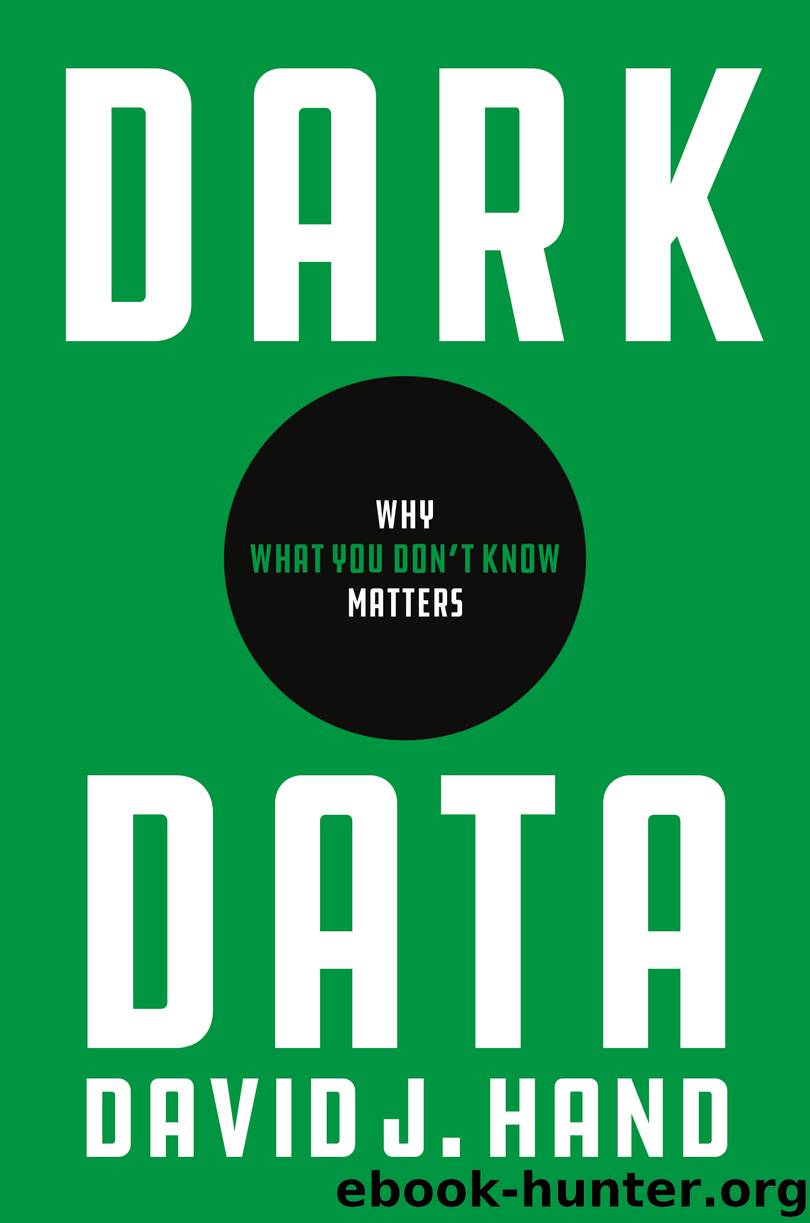Dark Data by David J. Hand

Author:David J. Hand
Language: eng
Format: epub
Publisher: Princeton University Press
Published: 2019-11-08T16:00:00+00:00
If Only I’d Known That
Since the scientific process consists of testing conjectured explanations against real data, it is hardly surprising that potential explanations often turn out to be wrong. If this were not the case, the entire enterprise would be simplicity itself. And while great scientists are immortalized because of the theories they came up with which turned out to be good explanations for empirical phenomena, this does not mean they don’t also produce their share of mistaken theories along the way. Often, this is because something they don’t know about is discovered, or because new data have been collected.
One of Charles Darwin’s most outspoken critics was Sir William Thomson, who later became Lord Kelvin (after whom the temperature scale is named). He was one of the most eminent scientists of his day, becoming Professor of Mathematics at Cambridge at the age of 22. He is buried in Westminster Abbey with Isaac Newton (and, more recently, Stephen Hawking). Previous physicists had estimated how long the sun would last, based on the assumption that it was burning fossil fuels like coal, but Kelvin recognized that this would mean it would burn for only a few thousand years. So he developed a suggestion from Hermann von Helmholtz that it was gradually contracting, and that the gravitational energy released by the contraction was being converted into heat and light. Even so, he calculated, the sun could not possibly have kept burning for long enough for life to have evolved on Earth, so he argued that Darwin’s theory of evolution did not fit the data.
But Kelvin was wrong. Crucial data—which became available only later—were missing from his argument. These were data showing that the mechanism behind the sun’s energy was not chemical burning or gravity but a new kind of thing altogether: nuclear fusion.
Nuclear fusion is the process by which atomic nuclei are forced together so powerfully that they merge into a single larger atomic nucleus. In the process some mass is lost, and this mass is converted into energy, which is radiated away. The conversion factor is such that a tiny amount of mass transforms into an enormous amount of radiated energy, as is demonstrated by the detonation of a hydrogen bomb. The fuels for such reactions are deuterium (which is a hydrogen atom whose nucleus has a neutron as well as a proton; an ordinary hydrogen nucleus has no neutron) and radioactive tritium (a hydrogen atom whose nucleus contains two neutrons and a proton), which is produced in nuclear reactors by bombardment of the isotope lithium-6 with neutrons. The magnitude of the power which can be generated is illustrated by the fact that, theoretically, half a bathtub of water plus the lithium from one laptop battery would yield electricity equivalent to burning 40 tons of coal. Such a source of energy would solve humanity’s energy problems, and we could do away with the pollution-generating fossil-fuel power stations: nuclear fusion reactions are “clean” in the sense that no radioactive waste is produced. This sort of reaction is the source of the sun’s energy.
Download
This site does not store any files on its server. We only index and link to content provided by other sites. Please contact the content providers to delete copyright contents if any and email us, we'll remove relevant links or contents immediately.
| Biomathematics | Differential Equations |
| Game Theory | Graph Theory |
| Linear Programming | Probability & Statistics |
| Statistics | Stochastic Modeling |
| Vector Analysis |
Modelling of Convective Heat and Mass Transfer in Rotating Flows by Igor V. Shevchuk(6345)
Weapons of Math Destruction by Cathy O'Neil(6069)
Factfulness: Ten Reasons We're Wrong About the World – and Why Things Are Better Than You Think by Hans Rosling(4611)
Descartes' Error by Antonio Damasio(3181)
A Mind For Numbers: How to Excel at Math and Science (Even If You Flunked Algebra) by Barbara Oakley(3173)
Factfulness_Ten Reasons We're Wrong About the World_and Why Things Are Better Than You Think by Hans Rosling(3152)
TCP IP by Todd Lammle(3089)
Applied Predictive Modeling by Max Kuhn & Kjell Johnson(2970)
Fooled by Randomness: The Hidden Role of Chance in Life and in the Markets by Nassim Nicholas Taleb(2959)
The Tyranny of Metrics by Jerry Z. Muller(2946)
The Book of Numbers by Peter Bentley(2865)
The Great Unknown by Marcus du Sautoy(2605)
Once Upon an Algorithm by Martin Erwig(2533)
Easy Algebra Step-by-Step by Sandra Luna McCune(2530)
Lady Luck by Kristen Ashley(2490)
Practical Guide To Principal Component Methods in R (Multivariate Analysis Book 2) by Alboukadel Kassambara(2441)
Police Exams Prep 2018-2019 by Kaplan Test Prep(2435)
All Things Reconsidered by Bill Thompson III(2320)
Linear Time-Invariant Systems, Behaviors and Modules by Ulrich Oberst & Martin Scheicher & Ingrid Scheicher(2298)
